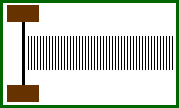Guitars (and other musical instruments) are heard through a physics concept called 'sound waves'. Sound waves are essentially vibrations that are produced by vibrating objects. In this case, the vibrating object is a guitar string. The sound wave that is produced is called a 'longitudinal wave', which is composed of compressions and rarefactions.

Compression:
A compression is an area of the wave where there is high pressure and the air molecules are 'squeezed' together in a small region of space.
Rarefaction:
A rarefaction is an area of the wave where there is a small amount of pressure. Here, the air molecules are more spread apart.
Shown above is an example of a guitar string producing a longitudinal wave. As the string moves to the right, it compresses the air particles. Then as it moves back to the left, pressure on the air particles is decreased and a region of rarefaction is created. This process continues on until the string stops oscillating (and thus no sound is being produced).